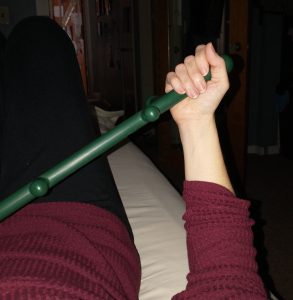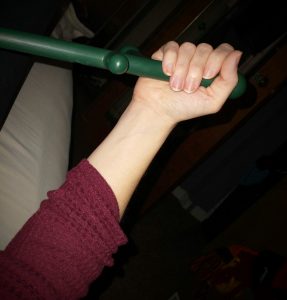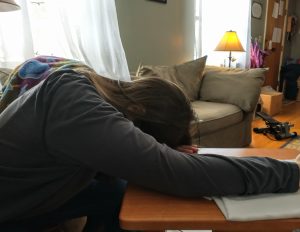It’s been a week since my first physical therapy appointment, two weeks since surgery, and I’ve been working hard on my home exercises. My hardest exercises are the ones geared towards increasing my range of motion to achieve my first goal — 120 degrees of forward flexion and 20 degrees of external rotation at 4 weeks after surgery. As I’ve mentioned before, my shoulder is VERY tight. This is by design. After the dislocation my shoulder was much, much too loose. Along with the repair work he did, the surgeon tightened up the joint capsule to restore stability to the joint. So now I need to gradually work it back into a functional range of motion.
One of the weirder things about this process is how much my proprioception and joint position sense, my sense of how my arm and joint are positioned in space, is very off. Most of the receptors that send that information to our brain are located in the joint capsule.
I noticed back before surgery that I had a feeling like my insides were shaking or vibrating, like an internal tremor. This started the day of the injury and continued until I had surgery. While I haven’t found a lot of research evidence (or any) about that, my theory is that it was due to my brain being more than a little bit freaked out about the feeling of my shoulder being completely unstable and the capsule being all stretched out. That feeling stopped after I had surgery.
Now that the joint capsule as been tightened up my brain has not yet relearned how to interpret this joint position information from these receptors in their new, surgically-modified positions. This position where I’m lying on my back and my forearm essentially points straight up to the ceiling is considered 0 degrees of rotation.

But when I close my eyes it absolutely convincingly feels like it is at at least 50 degrees of external rotation.

But then I open my eyes and see that first 0 degree view. It’s the oddest thing.
It’s not quite as disoriented with shoulder flexion as it is with rotation. This makes sense because external rotation stretches out the anterior joint capsule more than flexion. The anterior joint capsule is the part that had to go through the most stretching out from the dislocation and subsequent tightening for the repair. Still I had my husband take this photo of me working on a table slide flexion exercise so that I could see how the joint angle is coming along because I’m not totally sure how reliable my joint position sense is for this plane of motion either.

Most of what I work on with my patients is related to this concept of proprioception. I specialize in finding ways to get the best information to a patient’s brain from their muscles and joints so that they can then have the best, most efficient output coming from the brain to the musculoskeletal system, then back and forth that conversation goes, hopefully with a higher and higher quality of information. This is giving me a close-up experience with relearning this after a significant reorganization! The neurological system is so cool.